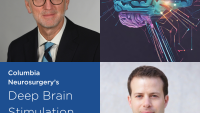Parkinson’s Disease
Make an Appointment
Our team of dedicated access representatives is here to help you make an appointment with the specialists that you need.
Parkinson’s disease (PD, Parkinson Disease, Parkinson Syndrome, Atypical Parkinson, or Parkinsonism or, simply, Parkinson) is a slowly progressing, degenerative disease that is the most common form of Parkinsonism, a group of motor system disorders.
For some time it was incorrectly believed that Parkinson’s disease disappeared after the introduction of levodopa (L-dopa) in the 1960s. In fact, about 50,000 Americans are diagnosed with Parkinson's disease each year, with more than half a million Americans affected at any one time. Further, more people suffer from Parkinson’s disease than multiple sclerosis, muscular dystrophy, and amyotrophic lateral sclerosis combined.
Parkinson’s disease is chronic (persists over a long period of time), and progressive (symptoms grow worse over time).
Although the disease may appear in younger patients (even teenagers), it usually affects people in late middle age. The disease affects men and women in almost equal numbers. It is not contagious, nor is it likely passed on from generation to generation.
Symptoms
Primary symptoms
The following are the most common symptoms of Parkinson’s disease. However, each individual may experience symptoms differently. Symptoms may include:
- Rigidity: stiffness when the arm, leg, or neck is moved back and forth.
- Resting tremor: tremor (involuntary movement from contracting muscles) that is most prominent at rest.
- Bradykinesia: slowness in initiating movement.
- Loss of postural reflexes: poor posture and balance that may cause falls; gait or balance problems.
Other symptoms
Symptoms of Parkinson’s disease vary from patient to patient. The symptoms may appear slowly and in no particular order. Early symptoms may be subtle and may progress over many years before reaching a point where they interfere with normal daily activities. These often include the following:
- Fatigue or general malaise
- Trembling
- Difficulty arising from a seated position
- Lowered voice volume (dysarthria)
- Small, cramped, spidery handwriting
- Losing track of a word or thought
- Irritability or sadness for no apparent reason
- Lack of expression in the face
- Lack of animation
- Remaining in a certain position for long period of time
- Unable to normally move arm or leg
Secondary symptoms
- Depression
- Senility
- Difficulty with speaking
- Emotional changes (fearful and insecure)
- Memory loss and slow thinking
- Difficulty in swallowing and chewing
- Urinary problems or constipation
- Skin problems
- Sleep problems
As the disease progresses, walking may become affected, causing the patient to stop in mid-stride or “freeze” in place, and maybe even fall over. Patients also may begin walking with a series of quick, small steps as if hurrying forward to keep balance, a practice known as festination.
The symptoms of Parkinson’s disease may resemble other conditions or medical problems. Always consult your physician for a diagnosis.
Diagnosis
Making an accurate diagnosis in the early stages of Parkinson’s disease can be difficult, and may require observation of the patient for some time until it is apparent that the tremor is consistently present and is joined by one or more of the other classic symptoms.
Currently, there are no specific tests for diagnosing PD, although there are several methods for evaluating its presence, including the following:
- Neurological examination–(including evaluation of symptoms and their severity)
- Trial test of drugs—when symptoms are significant, a trial test of drugs (primarily levodopa [L-dopa]) may be used to further diagnose the presence of PD. If a patient fails to benefit from levodopa, a diagnosis of Parkinson disease may be questionable.
- Computed tomography scan (CT or CAT scan)—a diagnostic imaging procedure that uses a combination of x-rays and computer technology to produce cross-sectional images (often called slices), both horizontally and vertically, of the body. A CT scan shows detailed images of any part of the body, including the bones, muscles, fat, and organs. CT scans are more detailed than general x-rays.
- Magnetic resonance imaging (MRI)—a diagnostic procedure that uses a combination of large magnets, radiofrequencies, and a computer to produce detailed images of organs and structures within the body.
- Positron Emission Tomography (PET)–is a scanning technique used in conjunction with small amounts of radiolabeled compounds to visualize brain anatomy and function.
Risk Factors
The specific cause of PD is unknown. However, medical experts believe the symptoms are related to a chemical imbalance in the brain caused by brain-cell death.
Patients are often classified as having primary Parkinsonism or idiopathic Parkinson’s disease. (Idiopathic is the term for a disorder for which no cause has yet been identified). In primary Parkinsonism, either the cause is known or suspected, or the disorder occurs as a secondary effect of another primary neurological disorder that may have both primary and secondary symptoms of Parkinson disease. These disorders, described as Parkinson Syndrome, Atypical Parkinson’s, or, simply, Parkinsonism, may include the following:
- Tumors in the brain
- Repeated head trauma
- Drug-induced Parkinsonism–prolonged use of tranquilizing drugs, such as the phenothiazines, butyrophenones, reserpine, and the commonly used drug, metoclopramide for stomach upset.
- Toxin-induced Parkinsonism–manganese and carbon monoxide poisoning.
- Postencephalitic Parkinsonism–a viral disease that causes “sleeping sickness.”
- Striatonigral degeneration–the substantia nigra of the brain is only mildly affected, while other areas of the brain show more severe damage.
- Parkinsonism that accompanies other neurological conditions–such as Shy-Drager syndrome (multiple system atrophy), progressive supranuclear palsy, Wilson’s disease, Huntington’s disease, Hallervorden-Spatz syndrome, Alzheimer’s disease, Creutzfeldt-Jakob disease, olivopontocerebellar atrophy, and post-traumatic encephalopathy.
Treatments
Specific treatment for a Parkinson’s disease will be determined by your physician based on:
- Your age, overall health, and medical history
- Extent of the condition
- Type of condition
- Your tolerance for specific medications, procedures, or therapies
- Expectations for the course of the condition
- Your opinion or preference
With today’s medicine, we have yet to find a cure for Parkinson’s disease. However, based upon the severity of the symptoms and medical profile, the physician will establish an appropriate treatment protocol. Treatment for Parkinson’s disease may include the following:
- Medications
- Surgery
Medication
Once the diagnosis of PD has been made, the next decision is whether a patient should receive medication, which depends on the following:
- The degree of functional impairment
- The degree of cognitive impairment
- Ability to tolerate antiparkinsonian medication
- The advice of the attending physician
No two patients react the same way to a given drugs. Therefore, it takes time and patience to find an appropriate medication and dosage to alleviate symptoms.
Surgery
Based on the severity of the condition and the medical profile, the physician may recommend surgery as one treatment option for Parkinson’s disease.
There are several types of surgery that may be performed that can help patients with Parkinson’s disease. Most of the treatments are aimed at helping the tremor or rigidity that comes with the disease. In some patients, surgery may decrease the amount of medication that is needed to control the symptoms of Parkinson’s disease, including the following:
There are three types of surgeries that may be performed for Parkinson’s disease, including the following:
- Lesion surgery (burning of tissue). In this procedure, deep parts of the brain are targeted and small lesions are made in critical parts of the brain that help control movement. The surgery may be done while the patient is awake to help determine the exact placement of the lesion. The lesion is placed to help control, or stop, the area of the brain that is causing the tremor.
- Deep brain stimulation (DBS). With this type of surgery, a small electrode is placed in the critical parts of the brain that help to control movement. The electrode is attached to a small battery in the chest wall and is connected by wires that are placed under the skin. The stimulator is then turned on and interrupts the normal flow of information in the brain and can help to decrease symptoms of Parkinson’s disease. The effects of DBS are essentially identical to lesioning. The greater flexibility/adjustability and safety of DBS over lesioning has resulting in DBS becoming nearly the sole surgery for Parkinson’s Disease currently as standard practice in the USA.
- Neural grafting or tissue transplants. Experimental research is being done to find a replacement for the part of the brain that functions improperly in Parkinson’s disease.
It is important to remember that surgery may help with symptoms of Parkinson’s disease, but does not cure the disease or stop the progression of the disease.


